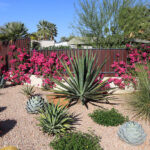Desert landscaping, also known as xeriscaping, is a type of landscaping that utilizes drought-tolerant plants and design techniques to create a beautiful and sustainable outdoor space. This type of landscaping is becoming increasingly popular in arid regions where water conservation is a priority. By using native plants and natural materials, desert landscaping can help reduce water usage and maintenance while still creating a visually appealing environment.
One of the key principles of desert landscaping is selecting plants that are well-suited to the local climate and soil conditions. Native plants are often the best choice for desert landscapes, as they are adapted to the harsh conditions of the environment and require less water and maintenance than non-native species. Some popular choices for desert landscaping include succulents, cacti, and drought-tolerant grasses and shrubs.
In addition to plant selection, the layout and design of a desert landscape are also important considerations. Drought-tolerant plants should be grouped together based on their water needs, with low-water plants in one area and higher-water plants in another. Mulching can also help retain moisture in the soil and reduce evaporation, while hardscaping elements like rocks and gravel can add interest and texture to the landscape.
Another benefit of desert landscaping is its environmental sustainability. By using native plants and reducing water usage, desert landscapes can help conserve water resources and support local wildlife populations. In addition, the minimal maintenance required for desert landscaping can help reduce the use of pesticides and fertilizers, further enhancing the environmental benefits of this type of landscaping.
Despite its many benefits, desert landscaping does require some special considerations and maintenance practices to thrive. Irrigation systems should be designed to deliver water efficiently and minimize waste, while regular monitoring of plant health and soil moisture levels is essential to ensure the landscape remains healthy and vibrant. Additionally, periodic pruning and weeding may be necessary to keep the landscape looking its best.
Overall, desert landscaping offers a sustainable and beautiful way to create outdoor spaces in arid environments. By using native plants, natural materials, and thoughtful design techniques, desert landscapes can be both water-efficient and visually striking. Whether creating a backyard oasis or designing a commercial space, desert landscaping can offer a practical and environmentally-friendly solution for outdoor living.













